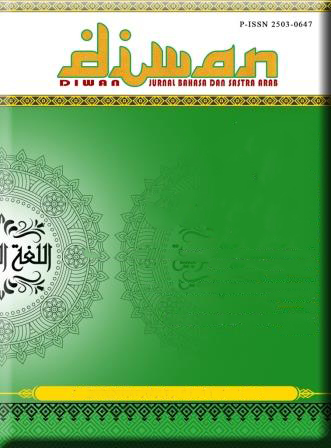Lexical Interference in the Indonesian Ministry of Religious Affairs' Qur’an Translation
Abstrak
بالرغم من الدراسات المتنوعة في مجال ترجمة القرآن الكريم من قِبل خبراء بارزين، فإنّ المخاوف المتعلقة بمشكلة التداخل المعجمي في ترجمة القرآن لم تُستكشَف بشكلٍ كافٍ. وقد حاولت هذه الدراسة مناقشة هذه القضية من خلال النظر في عملية ترجمة القرآن من قِبل وزارة الشؤون الدينية الإندونيسية. استُخدم في هذا البحث تصميم دراسة الترجمة كمنتج، حيث تم إجراء ملاحظات نصية لجمع البيانات ذات الصلة. ولتحليل البيانات، تمّ تبنّي نظرية ثوابته. وتوصّلت النتائج إلى بعض الاستنتاجات مفادها أن التداخل المعجمي في هذه الدراسة يشمل ما يلي من الترجمة: (1) الحروف المقطّعة، (2) المقاطع في بداية الآية، (3) تعدّد الدلالة اللفظية، (4) المصطلحات المستعارة من لغة المصدر إلى لغة الهدف، و (5) الضمائر. وتشير هذه الدراسة إلى أنّه قد يكون من الحكمة إضافة مفهوم ترجمة الضمائر إلى نظرية ثوابته، نظرًا لإغفال هذا المفهوم فيها فيما يتعلق بدراسات الترجمة.
Abstract
Despite extensive research on Qur'an translation by renowned scholars, concerns regarding lexical interference remain understudied. This paper addresses this gap by examining the Indonesian Ministry of Religious Affairs (IMRA)'s Qur'an translation through a product-oriented translation study design. Textual observations were employed for data collection, analyzed using Thawabteh's theory. Findings reveal five key areas of lexical interference: (1) syllabics (al-Aḥrūf al-Muqaṭṭa‘ah), (2) verse-initial syllables, (3) lexical polysemy, (4) loanwords, and (5) pronouns. The study suggests that Thawabteh's theory may benefit from incorporating the concept of pronoun translation, currently absent in translation studies.
##plugins.generic.usageStats.downloads##
Referensi
Al-Azab, Amir El-Said Ebrahim, and Othman Abdulaziz Al-Misned. “Pragmatic Losses of Qur’an Translation: A Linguistic Approach.” English Language and Literature Studies 2, no. 3 (2012).
Al-Azzam, Bakri, Mohammed Al-Ahaydib, and Eman Al-Huqail. “Cultural Problems in the Translation of the Qur’an.” International Journal of Applied Linguistics and Translation 1, no. 2 (2015).
Al-Damagānī, Al-Ḥusain bin Muḥammad. Qāmūs Al-Qur’ā Aw Iṣlāh Al-Wujūh Wa Al-Naẓā’ir fī Al-Qur’ān Al-Karīm. Edited by ‘Abdul ‘Azīz Sayyid Al-Ahl. Cet. IV. Beirut: Dār Al-‘Ilm li Al-Malāyīn, 1983.
Al-Qaṭṭān, Mannā‘ bin Khalīl. Mabāḥiṡ fī ‘Ulūm Al-Qur’Ān. Riyadh: Maktabah al-Ma‘ārif, 2000.
Amir, Abdul Muiz, and Fahmi Gunawan. “Diskursus Penafsiran Ayat al-Huruf al-Muqaththa’ah: Studi Analisis Tekstual dan Kontekstual.” MIQOT: Jurnal Ilmu-Ilmu Keislaman 43, no. 1 (2019). https://doi.org/10.30821/miqot.v43i1.615.
———. “Diskursus Penafsiran Ayat al-Huruf al-Muqaththa’ah: Studi Analisis Tekstual dan Kontekstual.” Miqot: Jurnal Ilmu-Ilmu Keislaman 43, no. 1 (2019).
Az-Zarqānī, Muḥammad ‘Abd al-Azīm. Manāhil al-’Irfan fī ‘Ulūm Al-Qur’Ān. Beirut: Dār al-Fikr, 1996.
Badan Pengembangan dan Pembinaan Bahasa. “Kamus Besar Bahasa Indonesia.” Website Version, 2016.
Baihaki, Egi Sukma. “Penerjemahan Al-Qur’an: Proses Penerjemahan Al-Qur’an di Indonesia.” Jurnal Ushuluddin, 2017. https://doi.org/10.24014/jush.v25i1.2339.
Baihaqi, Yusuf. “Îjâz of Al-Qur’an in Perspective of An Noursi and Its Implication Towards the Translation of Al-Qur’an.” Jurnal Al-Bayan: Jurnal Jurusan Pendidikan Bahasa Arab 11, no. 2 (2019). https://doi.org/10.24042/albayan.v11i2.4683.
Choi, Jinsil, and Kyung Hye Kim. “Translating Islamic Knowledge for the New Soil: Two Korean Translations of the Qur’an in South Korea.” Interventions 23, no. 7 (2021).
Dulay, H., Burt, M., & Krashen, S. Language Two. New York: Oxford Press, 1982.
Dweik, Bader S., and Zainab A. Othman. “Lexical and Grammatical Interference in the Translation of Written Texts from Arabic into English.” Academic Research International 8, no. 3 (2017).
Elmarsafy, Ziad. “Translations of the Qur’an: Western Languages.” Religion Compass 3, no. 3 (2009).
Elnemr, Mahmoud Ibrahim Rezk. “The Ideological Impact on the English Translations of the Qur’an: A Case Study of Muhammad Asad’s Translation.” International Journal of Linguistics, Literature and Translation 3, no. 7 (2020).
Gunawan, F., M. R. Nababan, H. Syukri, and I. Burdah. “Al-Qur’an Translation in Indonesia: A Case Study of Muhammad Thalib’s Qur’an Translation with Reference to Surah Yasin.” In International Conference on Communication, Language, Literature, and Culture, 1–13. Surakarta: ICCoLLiC, 2020.
Gunawan, Fahmi. “The Ideology of Translators in Quranic Translation: Lessons Learned from Indonesia.” Cogent Arts & Humanities 9, no. 1 (2022).
Hassanein, Hamada. “Translating Qur’anic ‘X-Phemisms’ Muslims Live by: A Pragmasemantic Reading.” Translation and Interpreting Studies 16, no. 1 (2021).
Hummadi, A. S., S. B. Mat Said, R. M. Hussein, A. A. Sabti, and H. A. A. Hattab. “(2020). Rhetorical Loss in Translating Prepositional Phrases of the Holy Qur’an.” SAGE Open 10, no. 1 (2020).
Movahhedian, Mahboubeh, and Mohammad Yazdani. “Extended Metaphor in the Glorious Qur’an Through Translation: A Case Study.” Translation Studies Quarterly 18, no. 69 (2020).
Mustafa, Burçin K. “Ambiguity, Ideology, and Doctrine Propagation in Qur’an Translation.” Journal of Qur’anic Studies 21, no. 11 (2019).
Nurdin, N., and Nadilla Baimal Puteri. “Perbandingan Metode Transformasi Wavelet dan Fourier dalam Penterjemahan Ayat pada Surah Yasin.” Sistemasi: Jurnal Sistem Informasi 9, no. 1 (2020).
Rahimi, Khovaygani Mohammad. “The Lexical Critique of Mousavi Garmaroudi’s Translation of the Holy Qur’an (Relying on the Lexical Semantic Theory of Garces).” Quran Hadith Translation Studies 4, no. 7 (2018).
Riddel, Peter G. “Menerjemahkan Al-Qur’an ke dalam Bahasa-Bahasa di Indonesia.” In Sadur Sejarah Terjemahan di Indonesia dan Malaysia, edited by dalam Henri Chambert-Loir, 397. Jakarta: Kepustakaan Populer Gramedia, 2009.
Satti, Mohamed, Hamed Mohamed, Qatar Doha, and Doha Bank. “Investigating Lexical Errors and Their Effect on University Students’ Written Performance in Sudan.” International Journal of English Language and Linguistics Research, 2015.
Syahrullah, S. “Tarjamah Tafsiriah terhadap Al-Qur’an: Antara Kontekstualisasi dan Distorsi.” Journal Of Qur’an and Hadith Studies 2, no. 1 (2013).
Syatri, Jonni, Ali Akbar, Abdul Hakim, Zarkasi, Mustopa, Ahmad Jaeni, and Muhammad Musadad. “Sikap dan Pandangan Masyarakat terhadap Terjemahan Al-Qur’an Kementerian Agama.” Suhuf 10, no. 2 (2017). https://doi.org/https://doi.org/10.22548/shf.v10i2.260.
Thawabteh, Mohammad Ahmad. “The Intricacies of Linguistic Interference in Arabic-English Translation.” Arab World English Journal 4, no. 2 (2013).
Weinreich, U. Languages in Contact: Findings and Problems. Amsterdam: John Benjamins Publishing Company, 2011.
Zakaria, Mohd Fahimi. “Asālib Al-Tarjamah Fī Af‘āl Al-Amr fī Al-Qur’ān Karīm Tafsīr Surah Yāsin min Tafsīr Nur Al-Iḥsān.” Jurnal Kesidang 5, no. 1 (2020).













